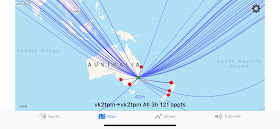There is some data available from the HFCC - International Broadcasting Delivery.
The files are fixed width fields which list broadcasts by frequency along with start time, end time, which days of the week, the country, the broadcaster and more.
Countries may have multiple broadcasts on different frequencies at the same time.
To measure output, I calculated the minutes on air of each listed broadcast and multiplied it by the number of days in each week that it's on and aggregated them by country.
Here are the top broadcasters as at August 2019. (Click for larger view).
Here's 2010. It's China, USA, Russia...
Here's 2000. Russia, USA, China. How times have changed.
Here's the changes amongst the top broadcasters now over this period. China is clearly on the rise.
There are many flaws in my simple analysis:
- Shortwave is used within large countries such as India and China for internal consumption.
- Different power levels and transmitter site and antenna direction should be taken in to account.
- The data may not cover all broadcasts "At present about 85 percent of the overall amount of global shortwave frequency requirements used for broadcasting is kept in this database. The missing 15 percent comprises some smaller stations in Africa and Latin America, as well as stations in the so called tropical broadcasting zone that employ shortwave transmissions for local listeners and are not interested in international co-ordination."
- Some transmitters use more than one antenna system at a time (beaming in different directions), currently I count those as two broadcasts.
- Radio New Zealand International provides programs which are broadcast in the Solomon Islands and Vanuatu but I'm counting those as broadcasts from the administration countries rather than NZ.
- Several people have commented that the UK seems under represented in this data.
- There are, of course, other options including satellite, FM relay, and internet streaming but this post isn't about those.
I note with sadness that in 2010, Australia was placed 12th, in 2019 we are 57th.
Please let me know if someone else has done any analysis in this area. My thanks to HFCC - International Broadcasting Delivery for making this valuable data freely available.






















